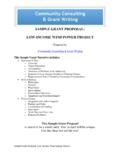Transcription of IEEE 802.11be — Extremely High Throughput: The Next ...
1 1. IEEE Extremely High Throughput: The Next generation of Wi-Fi Technology Beyond David Lo pez-P erez, Adrian Garcia-Rodriguez, Lorenzo Galati-Giordano, Mika Kasslin, and Klaus Doppler Abstract Wi-Fi technology is continuously innovating to cater office and cloud computing pose the stringiest requirements, to the growing customer demands, driven by the digitalisation of including sub-5 ms latency needs. Reliability is also a major everything, both in the home as well as the enterprise and hotspot concern in the emerging digital industry, where guarantee- spaces. In this article, we introduce to the wireless community the next generation Wi-Fi based on IEEE Extremely High ing that of the data packets are correctly delivered Throughput (EHT) , present the main objectives and timelines within their given deadline may be the bare minimum to of this new amendment, thoroughly describe its main replace wired with wireless communications. With these high- [ ] 27 Sep 2019.
2 Candidate features and enhancements, and cover the important throughput, low-latency and high-reliability requirements1 , issue of coexistence with other wireless technologies. We also consumers will demand a further improved Wi-Fi. provide simulation results to assess the potential throughput gains brought by with respect to To address such expectations, the IEEE work- ing group (WG) responsible for the standardisation of the I. I NTRODUCTION medium access control (MAC) and physical (PHY) layers of Wi-Fi products has already initiated discussions on new tech- Wi-Fi technology is among the greatest success stories of nical features for bands between 1 and GHz to make sure this new technology era, and its societal benefits are known that Wi-Fi products deliver up to the highest standards. To this to most of the world population. Wi-Fi has connected and end, and more concretely, the IEEE WG approved the entertained people, and has assisted in the creation of new formation of a topic interest group (TIG), and subsequently, a technologies, industries and careers around the globe.
3 Accord- study group (SG) and a task group (TG) on May 2018, July ing to a recent report from the Wi-Fi Alliance [1], more than 2018 and May 2019, respectively. These groups had and still 9 billion Wi-Fi devices are currently in use world-wide, where have the primary objective of ensuring that the next generation individuals, families, governments and global organisations of Wi-Fi referred to as IEEE Extremely High depend on Wi-Fi every day. According to the same report, Throughput (EHT) meets the peak throughput requirements the economic value provided by Wi-Fi reached the astounding set by upcoming applications [3]. amount of nearly $2 trillion by 2018, and is forecasted to grow In this article, we introduce the main objectives of , to almost $ trillion by 2023. Since Wi-Fi has become an es- as well as the views from different Wi-Fi stakeholders sential part of the home, and a key complementary technology about the process and timelines to generate such amendment for both enterprise and carrier networks, this economic value (Sec.)
4 II). We dive into the main candidate technical features is only expected to increase beyond 2023, as the newly defined of , presenting each one of them, and describing generation of more capable Wi-Fi products Wi-Fi 6, based on their benefits and challenges (Sec. III). Moreover, we discuss the most recent Institute of Electric and Electronic Engineers the important issue of coexistence (Sec. IV), and we provide (IEEE) specification [2] becomes widely available. system-level simulation results that show some of the potential Concurrently, the requirements of wireless data services throughput gains that may provide (Sec. V). Al- continue to increase in many scenarios such as homes, enter- together, this article aims to become an accessible guide to prises and hotspots, beyond the capabilities of Wi-Fi 6. Video for researchers and the general audience interested traffic will be the dominant traffic type in the years to come, in Wi-Fi. and its throughput demand will keep growing to tens of Gbps with the emergence of more sophisticated technologies, II.
5 O BJECTIVES AND TIMELINE. 4k & 8k video. Simultaneously, new applications demanding both high-throughput and low-latency are also proliferating. The Wi-Fi community is aiming high, with the recently Among these, augmented and virtual reality, gaming, remote established (TG) targeted at i) enabling new MAC and PHY modes of operation capable The authors are with Nokia Bell Labs. 2019 IEEE. Personal use of this material is permitted. Permission from of supporting a maximum throughput of at least 30 Gbps, IEEE must be obtained for all other uses, including reprinting/republishing measured at the MAC data service access point (AP) . this material for advertising or promotional purposes, collecting new collected 4 using carrier frequencies between works for resale or redistribution to servers or lists, or reuse of any copyrighted component of this work in other works. 1 and GHz, while Digital Object Identifier The published version of the article can be found at: 1 Other quality of service key performance indicators may apply depending of the service nature.
6 2. Date May 2018 July 2018 March 2019 May 2019 Sept. 2020 May 2021 Nov. 2022 Nov. 2023 May 2024. t EHT topic interest EHT study EHT project task Feature Industrial product group (TIG) group (SG) authorization group (TG) selection Standard certification request (PAR) drafts Fig. 1: Illustration of the initial standardization timeline agreed by stakeholders. ii) ensuring backward compatibility and coexistence with an option [7]. Moreover, a minimum channel size of 40 or legacy devices in the , 5 and 6 GHz unlicensed even 80 MHz in the 6 GHz band also seems appropriate when bands [3]. compared to the 20 MHz one used in the and 5 GHz bands, Moreover, will define at least one mode of operation given the focus on Extremely high throughput. capable of improved worst case latency and While the benefits of using the 6 GHz band to enhance Traditionally, major amendments, such as peak and system throughputs are obvious, the usage of a or , have taken 6+ years to complete, with new band also opens up the opportunity for new networking i) a development process effectively serialised TG for- approaches.
7 For example, there are on-going discussions on mation, feature set definition, draft development and whether APs should i) always schedule certification process , and uplink transmissions in the 6 GHz band thereby reducing the ii) no major overlap between subsequent amendments. time spent on channel contention , and ii) have the capability to request devices to vacate the 6 GHz band on In the first meeting of the TG, held on May 2019, demand, to reinforce such coordinated access. the TG members decided to stick to the current and so far successful amendment development model but with a shorter time span. The approved timeline is at least 6 months faster B. Multi-band/multi-channel aggregation and operation than that of , and is illustrated at the top of Fig. 1. With the emergence of dual-radio STAs and tri-band APs This next major amendment is expected to span 5 years capable of simultaneously operating at , 5 and 6 GHz, one and deliver massive and not just moderate enhancements of the main objectives of is to make a more efficient on many fronts for multitudinous customers and use use of these multiple bands and channels therein.
8 We describe cases. This timeline also enables the Wi-Fi Alliance to develop four of the most appealing techniques being considered by appropriate certifications of high profile features in a timely in the following [8]. manner to satisfy market needs [5]. a) Multi-band data aggregation. The aggregation of 5 and 6 GHz spectrum for data transmission or reception is a III. C ANDIDATE TECHNICAL FEATURES. feature fully aligned with fundamental objective A variety of candidate technical features have been proposed of enhancing Wi-Fi's peak throughput [8]. Effectively, by numerous industrial and academic experts in the this aggregation may require Wi-Fi devices to synchronise fora. In the following, we describe those that have attracted the start of the transmission opportunity (TXOP) in the most attention. different bands, therefore making this approach more efficient in sparsely populated scenarios where contention A. 320 MHz bandwidth and more efficient utilisation of non- for channel access is generally smoother.
9 Contiguous spectrum b) Simultaneous transmission and reception in different Spectrum is the air that wireless networks breath, and bands/channels. This feature, also commonly referred to any new generation of radio technology always attempts to as multi-band/multi-channel full duplex, has the potential leverage the usage of new spectrum bands, as they become of reducing the communication latency and enhancing the available. is no exception, and following the initial throughput by enabling an asynchronous and simultane- steps of , Wi-Fi stakeholders embrace the usage of ous uplink/downlink operation in separate bands/channels the 6 GHz band as an immediate approach to increase Wi-Fi [8]. If this feature is to be included in , a peak throughput, as shown in Fig. 2. In this regard, discussions minimum separation between the downlink and uplink about the most efficient approaches to operate the up to channels within the same band is likely to be included GHz of potentially accessible unlicensed spectrum between to prevent uplink to downlink and downlink to uplink and GHz which more than doubles the available interference.
10 Bandwidth in the 5 GHz band are ongoing. c) Simultaneous transmission and reception in the same The adoption of 160 MHz and 320 MHz communication channel. In parallel to the TG, the bandwidth per AP in the 6 GHz band as mandatory and op- WG also approved the formation of a TIG in January tional features, respectively, seems a sensible choice, building 2018 to examine the technical feasibility of full duplex on , where 160 MHz bandwidth per AP is already operation for Wi-Fi [9]. The TIG finished its activity in December 2018, concluding that full duplex operations 2 It is important to note the TG has not defined any specific can be realised with minor modifications to the objectives in terms of latency and/or reliability so far, and a more detailed analysis on this matter was carried out by the real time application (RTA) standard, and can yield various benefits such as increased TIG [4]. throughput per STA, reduced latency, collision detection 3.
![arXiv:0706.3639v1 [cs.AI] 25 Jun 2007](/cache/preview/4/1/3/9/3/1/4/b/thumb-4139314b93ef86b7b4c2d05ebcc88e46.jpg)

![arXiv:1301.3781v3 [cs.CL] 7 Sep 2013](/cache/preview/4/d/5/0/4/3/4/0/thumb-4d504340120163c0bdf3f4678d8d217f.jpg)
![@google.com arXiv:1609.03499v2 [cs.SD] 19 Sep 2016](/cache/preview/c/3/4/9/4/6/9/b/thumb-c349469b499107d21e221f2ac908f8b2.jpg)













